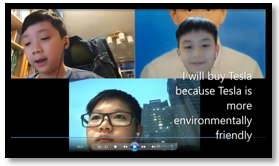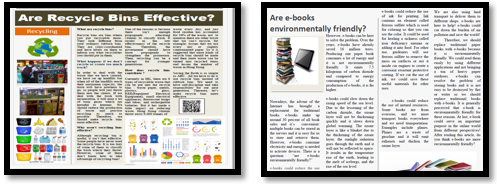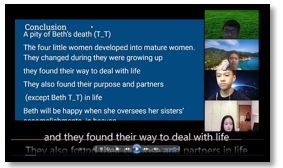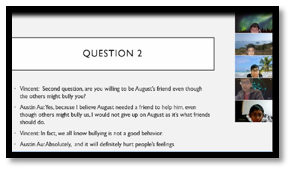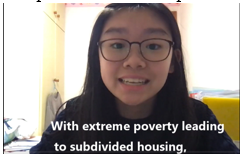Learning beyond designated curriculum contents and lesson time
Background
The major concerns of Pui Ching Middle School were to enhance students' learning effectiveness and help students build up a purpose-driven life. In response to the recommendations of the Task Force on Review of School Curriculum (Task Force), the school reviewed and reorganised its senior secondary curriculum to create space to address those concerns. The space created was utilised for implementing measures at the school level by offering co-curricular courses for all S4 students to address their diverse needs, interests and aspirations and in the school English Language curriculum by introducing self-directed learning (SDL) projects in S1-4, thereby broadening students' horizons, connecting their learning to real-life experiences, and building a stronger interface between the junior and senior secondary curricula.
Level(s)
S1-4
Strategies used
Infusing values education and Life Planning Education elements into the school curriculum to foster students' whole-person development
Through reading extensively and working on SDL projects with a focus on future study and career, S4 students were exposed to related subjects and a variety of jobs. The SDL tasks aimed at encouraging them to explore themselves and realise their potential, thereby helping them realise their dreams and set goals for the future. Positive values and attitudes were also infused into the S1-3 SDL projects through making use of reading and multimedia resources on everyday life events or topics such as saving the environment, growing up and friendship.Maximising students' learning time by effectively reorganising learning experiences inside and outside the classroom
The Task Force recommended that learning time refers to not only classroom periods as students can gain learning experiences anywhere and anytime. The school holistically planned and arranged students' learning time to provide a variety of courses to cater for students' diverse needs and interests, and extended student learning outside lesson time through SDL. More opportunities were created for students to learn in order to allow them to get the most benefit out of learning inside and outside the classroom.Enhancing students' SDL capabilities to develop them into autonomous lifelong learners
According to the English Language Education Key Learning Area Curriculum Guide (Primary 1 – Secondary 6) (2017), we should develop students' SDL capabilities and habit by giving them more autonomy in learning. English teachers encouraged students to set goals, decide on the topics of SDL projects and the investigation methods, and conduct reflections. Through this learning process, teachers helped students develop independence and a sense of responsibility. Engagement in SDL projects enabled students to become more responsible for their own learning and to be lifelong learners.
What happened
School-level measures
As recommended in the Final Report of the Task Force, the school created space by reducing lessons from the senior secondary core subjects in S4 in 2021/22, which were transformed to a 3-lesson common block every Monday afternoon for a programme called "Journey for Knowledge" with a view to broadening students' horizons and catering for their diverse interests and aspirations. The objectives of the programme were to:
- help students become active learners;
- expand their fields of knowledge and horizons;
- enhance their competence in integrating learning and keeping abreast of the times so as to cope with the ever-changing challenges in the future; and
- cultivate their enthusiasm and commitment to serve society.
Students may choose one course from the following list in each of the two terms in S4 (and also in S5 in 2022/23):
A. Humanities and Social Sciences |
B. Mathematics, Science and Technology |
C. Self-directed Learning |
|
|
|
Subject-level measures
To extend students' learning from the classroom to beyond lesson time and to facilitate a smooth transition between Key Stages 3 and 4, English teachers incorporated SDL projects in the learning and teaching of reading skills in S1-4 to (a) motivate students to read and enable them to read deeper, (b) enable students to connect their learning in the English lessons to real-life experiences so as to promote positive values and attitudes (S1-3) and prepare them for future study (S4), thereby fostering their whole-person development, and (c) stretch the potential of students and cater for their diverse learning needs. Aiming at developing students into independent learners, the SDL projects engaged students in the following steps:
1. Set learning goals |
Students studied a topic related to the theme of the SDL project concerned, and planned how to present their findings as well as selected what presentation skills to adopt. |
2. Conduct research and read chosen texts |
Students chose reading texts and applied the reading skills they had learnt. They kept reading logs to monitor their own learning progress. |
3. Design and produce final products |
Students organised their ideas and produced their final presentations. |
4. Review the learning experience |
Students completed reflection forms to evaluate their learning and identify their strengths and weaknesses. |
The SDL projects were designed alongside existing textbook units and themes to provide students with opportunities to apply their learning in meaningful contexts, enrich their learning experiences and enhance their learning motivation. The following table outlines the mapping among the S1-4 textbook themes, target reading skills, SDL project themes and learning elements to foster students' whole-person development.
Levels and terms |
Textbook themes |
Extending learning beyond lesson time |
Fostering whole-person development |
|
Developing students' reading skills through |
Themes of SDL projects |
Elements of values education (S1-3) or future study/career (S4) infused |
||
S1 |
We Care |
|
Green living |
|
S1 |
Amazing People, Amazing Deeds |
|
Role models |
|
S2 |
Growing Up |
|
Growth mindset |
|
S2 |
All about Science |
|
Science for better living |
|
S3 |
Performance |
|
Musicals/Films with positive messages |
|
S3 |
Well-being |
|
Healthy living |
|
S4 |
Living Space |
|
Living and housing |
|
S4 |
Trade |
|
Trade |
|
Impact
School level
The school curriculum was optimised not only to cater for learner diversity and foster students' whole-person development, but also to help students live a purpose-driven life, one of the school's major concerns which aims at encouraging students to explore themselves and realise their potential through setting and pursuing life goals. The "Journey for Knowledge" programme offered students curriculum options beyond designated curriculum contents and broadened their horizons, thereby enhancing their self-understanding in the learning process and formulating career or learning targets. Despite the fact that it was just the first-year implementation in S4, the observations below reveal that the courses addressed students' diverse needs, interests and aspirations:
Students could make full use of their choices and study a total of 4 courses in S4 (2021/22) and S5 (2022/23).
Students chose courses from different areas such as Humanities and Social Sciences and Mathematics, Science and Technology, which facilitated their balanced development.
-
The courses were appealing to students as they showed more or less equal preferences for the choices available.
Subject level
New initiatives including flipped learning and SDL were infused into the school English Language curriculum to extend learning beyond lesson time. Teachers acted as facilitators who enabled students to gain the most benefit from learning, and encouraged students' active learning, engagement and ownership. For example, students were guided to learn at their own pace and according to their needs and interests, and were allowed to research SDL materials for preparation and presentation outside the classroom.
Other than extending learning beyond lesson time, a strong interface between the junior and senior secondary curricula was built through the following means:
Developing a reading curriculum to ensure balanced skills coverage and progression
Establishing a sound foundation of generic skills in preparation for lifelong learning through enhancing students' SDL capabilities and giving them timely feedback
-
Fostering students' whole-person development from cultivating positive values and attitudes at the junior secondary level to prepare them for future study/career at the senior secondary level through the SDL projects
Student level
Students' diverse interests and aspirations were catered for by the range of final products of the SDL projects, including individual presentations, forums, TV shows, plays, interviews and news articles. With appropriate support and space given for learning, they were able to learn and apply relevant language skills (e.g. reading skills) and generic skills in meaningful contexts, and the learning outcomes, as illustrated in the following table, were impressive and demonstrated their high level of learner autonomy.
Levels and SDL project themes |
Excerpts of student work |
|
S1 Green living |
Students were interviewed on their preferences for electric cars or gas-powered cars.
Students produced newspaper articles on environmental issues. |
|
S2 Growth mindset |
Students had a forum on how the characters in the book "Little Women" grew up and learnt to overcome obstacles. |
Students discussed problems the characters in the book "Wonder" encountered and how they should tackle challenges such as bullying. |
S3 Musicals or films with positive messages |
Students learnt to help and understand others from the book "The Curious Incident of the Dog in the Night-Time". |
Students acted out scenes of the book "Dear Evan Hansen" and showed care about others.(Click here to view the video.) |
S4 Living and housing |
Student presented how 3D printers could be used to build houses and solve housing problems. |
|
Student explored problems of subdivided housing. |
Student studied and presented Hong Kong's reclamation plan. |
|
(Click here to view the video.) |
||
From students' self-reflection on their performance in the SDL projects, it is evident that their SDL capabilities (e.g. choosing a topic of interest, selecting appropriate learning materials and evaluating their own learning) were enhanced (see table below).
Statements |
S1 |
S2 |
S3 |
S4 |
The topic I chose for the project was clear and well-focused. |
96.4% |
93.4% |
91.5% |
100% |
I could select and read some texts and find useful information for my topic. |
94.2% |
96.7% |
89.7% |
98% |
I could identify what I did well or not well and how to improve myself in the project. |
95.9% |
86.8% |
87.2% |
95.9% |
Furthermore, students have also demonstrated positive values and attitudes towards a range of work and social issues covered through written reflections, revealing that the optimised curriculum has progressively prepared them for future work and studies as well as fostered whole-person development among them.
Levels |
Students’ reflections (original unedited) |
Annotations |
S1 |
|
|
S2 |
|
|
S3 |
|
|
S4 |
|
|
Conclusion
In response to the recommendation to optimise the senior secondary core subjects, Pui Ching Middle School grasped the favourable opportunity to create space and implemented new measures in the curriculum at both school and English Language subject levels with a view to catering for students' diverse learning needs and fostering their whole-person development. The school management utilised teachers' expertise and human resources from different areas to offer curriculum options to facilitate students' broad and balanced development. At the subject level, English panel heads and teachers collaborated conscientiously to improve the school English Language curriculum and tried out new initiatives such as flipped learning and SDL projects to enrich student learning. They connected English learning in and beyond lessons and tied it in with values education and future study or career, so that students could relate English learning with their daily lives and build a purpose-driven life. The school has made students' learning benefits the priority of school development and would further review and develop the school curriculum based on ongoing evaluation. There is no doubt that their commitment to change and concerted efforts contributed greatly to effective school improvement, from which students would be the ultimate beneficiary.
Bibliography
Curriculum Development Council and the Hong Kong Examinations and Assessment Authority. (2021). English Language Education Key Learning Area Curriculum and Assessment Guide (Secondary 4-6). Hong Kong: Author.
Curriculum Development Council. (2017). Secondary Education Curriculum Guide. Hong Kong: Author.
Education Bureau. (2021). Guide on Life Planning Education & Career Guidance for Secondary Schools. 2nd Edition. Hong Kong: Author.
Task Force on Review of School Curriculum. (2020). Optimise the curriculum for the future, Foster whole-person development and diverse talents. Hong Kong: Author.
Pui Ching Middle School
Pearl KOAH (Language Support Officer)
